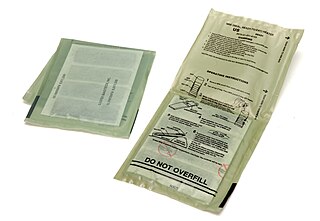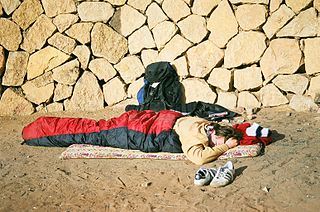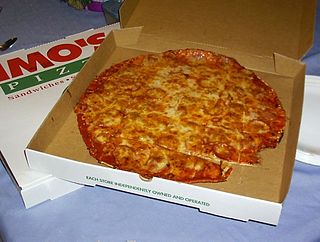
A vacuum flask is an insulating storage vessel that slows the speed at which its contents change in temperature. It greatly lengthens the time over which its contents remain hotter or cooler than the flask's surroundings by trying to be as adiabatic as possible. Invented by James Dewar in 1892, the vacuum flask consists of two flasks, placed one within the other and joined at the neck. The gap between the two flasks is partially evacuated of air, creating a near-vacuum which significantly reduces heat transfer by conduction or convection. When used to hold cold liquids, this also virtually eliminates condensation on the outside of the flask.

A flameless ration heater (FRH), colloquially an MRE heater, is a form of self-heating food packaging included in U.S. military Meal, Ready-to-Eat (MRE) rations since 1993.

A sleeping bag is an insulated covering for a person, essentially a lightweight quilt that can be closed with a zipper or similar means to form a tube, which functions as lightweight, portable bedding in situations where a person is sleeping outdoors. It is also commonly used indoors for people who do not have beds or at sleepovers. Its primary purpose is to provide warmth and thermal insulation through its synthetic or down insulation. It also typically has a water-resistant or water-repellent cover that protects, to some extent, against wind chill and light precipitation, but a tent is usually used in addition to a sleeping bag, as it performs those functions better. The bottom surface also provides some cushioning, but a sleeping pad or camp cot is usually used in addition to that purpose. The bottom surface of a sleeping bag may be moderately water repellent, but a plastic tarp or groundsheet is often used to protect against moist ground.

A cooler, portable ice chest, ice box, cool box, chilly bin, or esky (Australia) is an insulated box used to keep food or drink cool.

An ice pack or gel pack is a portable bag filled with water, refrigerant gel, or liquid, meant to provide cooling. They can be divided into the reusable type, which works as a thermal mass and requires freezing, or the instant type, which cools itself down using chemicals but can only be used once. The instant type is generally limited to medical use as a cold compress to alleviate the pain of minor injuries, while the reusable type is both used as a cold compress and to keep food cool in portable coolers or in insulated shipping containers to keep products cool during transport.

A cold chain is a supply chain that uses refrigeration to maintain perishable goods, such as pharmaceuticals, produce or other goods that are temperature-sensitive. Common goods, sometimes called cool cargo, distributed in cold chains include fresh agricultural produce, seafood, frozen food, photographic film, chemicals, and pharmaceutical products. The objective of a cold chain is to preserve the integrity and quality of goods such as pharmaceutical products or perishable good from production to consumption.

Induction sealing is the process of bonding thermoplastic materials by induction heating. This involves controlled heating an electrically conducting object by electromagnetic induction, through heat generated in the object by eddy currents.
Insulated shipping containers are a type of packaging used to ship temperature sensitive products such as foods, pharmaceuticals, organs, blood, biologic materials, vaccines and chemicals. They are used as part of a cold chain to help maintain product freshness and efficacy. The term can also refer to insulated intermodal containers or insulated swap bodies.
Aseptic processing is a processing technique wherein commercially thermally sterilized liquid products are packaged into previously sterilized containers under sterile conditions to produce shelf-stable products that do not need refrigeration. Aseptic processing has almost completely replaced in-container sterilization of liquid foods, including milk, fruit juices and concentrates, cream, yogurt, salad dressing, liquid egg, and ice cream mix. There has been an increasing popularity for foods that contain small discrete particles, such as cottage cheese, baby foods, tomato products, fruit and vegetables, soups, and rice desserts.
Metallised films are polymer films coated with a thin layer of metal, usually aluminium. They offer the glossy metallic appearance of an aluminium foil at a reduced weight and cost. Metallised films are widely used for decorative purposes and food packaging, and also for specialty applications including insulation and electronics.

Heated hoses are hoses used for transporting liquids or molten materials where integral heat is needed for temperature control. Heated hoses are used in bonding technology, filling and dosing systems, medical technology, chemical, pharmaceutical and food industry, extruder applications, and research & development. The heated hoses are used wherever a liquid, viscous or melted medium has to be transported from one place to another, e.g. chocolate, jelly or hotmelt. In most applications, the temperature of the medium needs to remain constant at a specified value irrespective of variations in ambient temperature. Several constructions are available.

A thermal cooker, or a vacuum flask cooker, is a cooking device that uses thermal insulation to retain heat and cook food without the continuous use of fuel or other heat source. It is a modern implementation of a haybox, which uses hay or straw to insulate a cooking pot.

Drug packaging is process of packing pharmaceutical preparations for distribution, and the physical packaging in which they are stored. It involves all of the operations from production through drug distribution channels to the end consumer.

Package testing or packaging testing involves the measurement of a characteristic or property involved with packaging. This includes packaging materials, packaging components, primary packages, shipping containers, and unit loads, as well as the associated processes.

A bag is a common tool in the form of a non-rigid container, typically made of cloth, leather, bamboo, paper, or plastic. The use of bags predates recorded history, with the earliest bags being lengths of animal skin, cotton, or woven plant fibers, folded up at the edges and secured in that shape with strings of the same material. Bags can be used to carry items such as personal belongings, groceries, and other objects. They comes in various shapes and sizes, often equipped with handles or straps for easier carrying.
Reusable packaging is manufactured of durable materials and is specifically designed for multiple trips and extended life. A reusable package or container is "designed for reuse without impairment of its protective function." The term returnable is sometimes used interchangeably but it can also include returning packages or components for other than reuse: recycling, disposal, incineration, etc. Typically, the materials used to make returnable packaging include steel, wood, polypropylene sheets or other plastic materials.

The pizza box or pizza package is a folding packaging box usually made of corrugated fiberboard in which hot pizzas are stored for take-out. The pizza box also makes home delivery and takeaway substantially easier. The pizza box has to be highly resistant, cheap, stackable, thermally insulated to regulate humidity and suitable for food transportation. In addition, it provides space for advertising. The pizza packages differ from those of frozen pizzas, which contain the frozen product in heat-sealed plastic foils as is the case with much frozen food.

Package handles, or carriers, are used to help people use packaging. They are designed to simplify and to improve the ergonomics of lifting and carrying packages. Handles on consumer packages add convenience and help facilitate use and pouring. The effect of handles on package material costs and the packaging line efficiencies are also critical. A handle can be defined as “an accessory attached to a container or part for the purpose of holding or carrying.” Sometimes a handle can be used to hang a package for dispensing or use.

Vaccine storage relates to the proper vaccine storage and handling practices from their manufacture to the administration in people. The general standard is the 2–8 °C cold chain for vaccine storage and transportation. This is used for all current US Food and Drug Administration (FDA)-licensed human vaccines and in low and middle-income countries. Exceptions include some vaccines for smallpox, chickenpox, shingles and one of the measles, mumps, and rubella II vaccines, which are transported between −25 °C and −15 °C. Some vaccines, such as the COVID-19 vaccine, require a cooler temperature between −80 °C and −60 °C for storage.

















